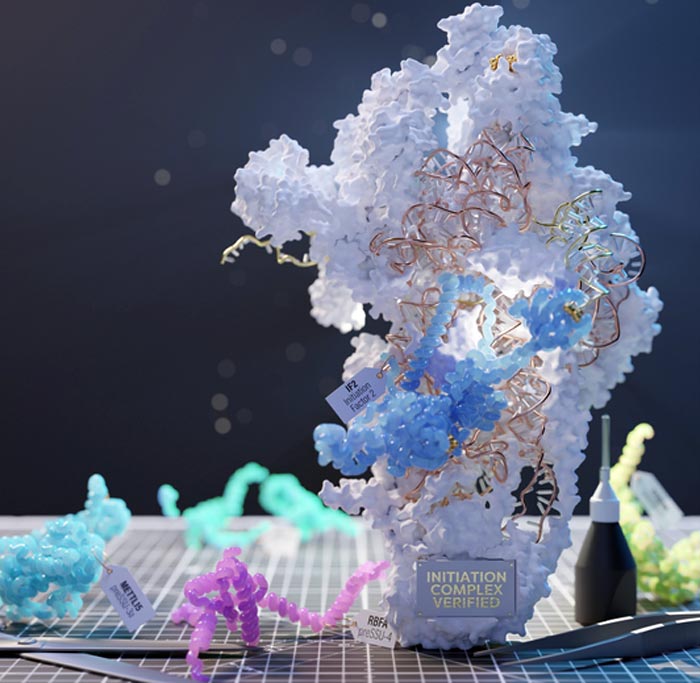Mechanism of mitoribosomal small subunit biogenesis and preinitiation

A series of the small mitoribosomal subunit intermediates in complex with auxiliary factors, revealing a sequential assembly mechanism.
Credit: Verena Resch
Mitoribosomes are nano particles essential for the synthesis and maintenance of bioenergetic proteins that produce more than 90% of our energy to support a human life. Eight years ago, the term Resolution Revolution was coined in relation to the first structure determination of the mitoribosome. Its intricate structure consists of over 80 different components, and more recent structural studies have further deepened our understanding of the mitoribosome structure, function and antibiotic binding.
However, we still lack information on the assembly of the mitoribosomal components that would explain how they cooperatively become to be the mitoribosome that is capable to initiate a protein synthesis. This is particularly important as defects in the assembly are linked to severe pathologies that manifest as a broad range of developmental disorders.
The paper published in Nature presents a cryo-EM analysis of assembly intermediates that explains how action of step-specific factors modulate the dynamic mechanism of biogenesis and establishes the catalytic mitoribosome that can activate our metabolism.
The data reveals a model for the progression through a multistep assembly pathway that includes a sequence of binding factors as an integrated network. The progression is controlled via an allosteric mechanism to promote a regulated and gradual maturation. The high resolution allowed to reveal how a premature binding of genetic material is blocked and also to detect essential gentle modifications that occur on the mitoribosomal core at each of the assembly steps.
Intriguingly, previously known as “initiation” factor mtIF3 binds already during the assembly, and a unique protein mS37 then disrupts its contact, which marks the completion of the assembly and the initiation of protein synthesis. Thus, the study features a new paradigm of a single protein that links the process of the assembly to the catalytic function of the mitoribosome that is capable of producing metabolic energisers for our cells.
Publication: ”Mechanism of mitoribosomal small unit biogenesis and preinitiation.” Yuzuru Itoh, Anas Khawaja, Ivan Laptev, Miriam Cipullo, Ilian Atanassov, Petr Sergiev, Joanna Rorbach and Alexey Amunts. Nature, online June 8, 2022, doi: 10.1038/s41586-022-04795-x
Website of the research group: https://amuntslab.org/
Journal: Nature
DOI: 10.1038/s41586-022-04795-x
Article Title: Mechanism of mitoribosomal small subunit biogenesis and preinitiation
Article Publication Date: 8-Jun-2022
Media Contact
Alexey Amunts
Science For Life Laboratory
amunts@scilifelab.se
Office: 460-816-1003
Original Source
All latest news from the category: Life Sciences and Chemistry
Articles and reports from the Life Sciences and chemistry area deal with applied and basic research into modern biology, chemistry and human medicine.
Valuable information can be found on a range of life sciences fields including bacteriology, biochemistry, bionics, bioinformatics, biophysics, biotechnology, genetics, geobotany, human biology, marine biology, microbiology, molecular biology, cellular biology, zoology, bioinorganic chemistry, microchemistry and environmental chemistry.
Newest articles

Superradiant atoms could push the boundaries of how precisely time can be measured
Superradiant atoms can help us measure time more precisely than ever. In a new study, researchers from the University of Copenhagen present a new method for measuring the time interval,…

Ion thermoelectric conversion devices for near room temperature
The electrode sheet of the thermoelectric device consists of ionic hydrogel, which is sandwiched between the electrodes to form, and the Prussian blue on the electrode undergoes a redox reaction…

Zap Energy achieves 37-million-degree temperatures in a compact device
New publication reports record electron temperatures for a small-scale, sheared-flow-stabilized Z-pinch fusion device. In the nine decades since humans first produced fusion reactions, only a few fusion technologies have demonstrated…





















